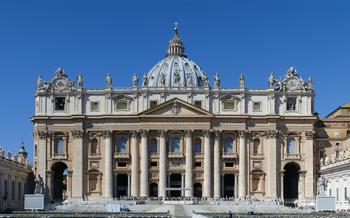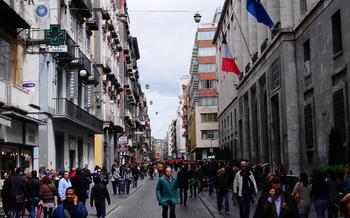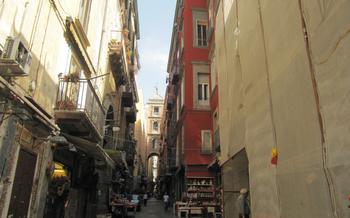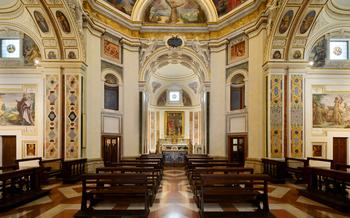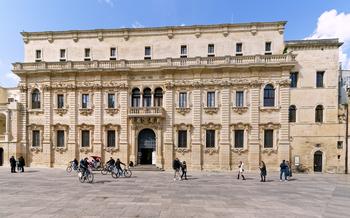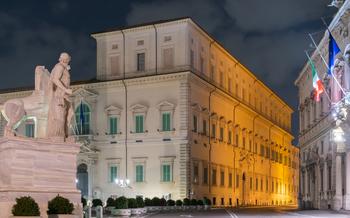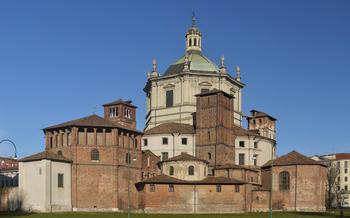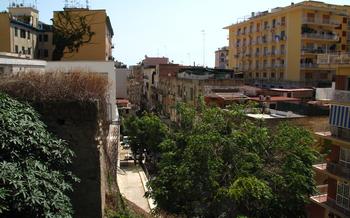
Gesù Vecchio Church
- Introduction: Unveiling the Splendors of Gesù Vecchio Church
- History
- Architecture
- Art and Frescoes
- Chapels and Altars
- Crypts and Catacombs
- Guided Tours
- Opening Hours and Admission
- Dress Code and Etiquette
- Photography and Videography
- Accessibility
- Nearby Attractions
- Local Cuisine and Dining
- Accommodation Options
- Insider Tip: Unearthing a Hidden Treasure
Introduction: Unveiling the Splendors of Gesù Vecchio Church
In the heart of Naples, a city renowned for its vibrant history and architectural marvels, lies the Gesù Vecchio Church, a testament to the city's rich Catholic heritage and artistic legacy. Built in the 16th century, this magnificent church stands as a beacon of Renaissance grandeur, inviting visitors to delve into its sacred spaces and uncover the stories etched in its walls. As you step through its doors, prepare to be captivated by the exquisite beauty, intricate artworks, and profound spiritual atmosphere that permeates this sacred sanctuary, leaving an indelible mark on your soul.
History
In the heart of Naples, amidst the bustling streets and vibrant atmosphere, stands the Gesù Vecchio Church, a testament to the city's rich history and religious heritage. Founded in the mid-16th century, the church was the brainchild of the Society of Jesus, a Catholic religious order known as the Jesuits. Seeking to establish a foothold in Naples, the Jesuits embarked on the construction of this grand edifice, designed to serve as a college and a spiritual center for the order.
Under the patronage of the Gesualdo family, a prominent Neapolitan dynasty, the church's construction commenced in 156Renowned architects of the time, including Pietro Provedi and Giovanni Tristano, lent their expertise to the project, creating a masterpiece that embodied the principles of the Renaissance architectural style. Despite numerous challenges, including financial constraints and political upheavals, the construction was completed in 1613, marking a significant milestone in the history of Neapolitan architecture.
Throughout its existence, the Gesù Vecchio Church played a pivotal role in the educational and spiritual life of Naples. The Jesuit college within the complex attracted students from prominent families, shaping the minds of future leaders and scholars. The church also served as a venue for religious gatherings, retreats, and spiritual exercises, becoming a hub of Catholic devotion in the city.
Architecture
The Gesù Vecchio Church is renowned for its striking architectural features, blending Renaissance and Baroque elements to create a visually stunning masterpiece. Its majestic facade, designed by Giacomo della Porta, showcases elegant curves, intricate carvings, and a harmonious balance of proportions. The main portal, flanked by two massive columns, invites visitors to step inside and explore the church's opulent interior.
Inside, the church boasts a spacious nave, framed by rows of graceful columns that support soaring arches. The transepts, extending from the nave, add depth and symmetry to the overall layout. The apse, where the main altar is located, features an intricate mosaic depicting the Assumption of the Virgin Mary, creating a celestial backdrop for religious ceremonies.
One of the most striking features of the Gesù Vecchio Church is its impressive dome, designed by Domenico Fontana. The dome, situated above the crossing of the nave and transepts, rises high above the church, creating a sense of awe and grandeur. Its intricate coffered ceiling, adorned with golden embellishments, adds a touch of opulence to the overall design.
Art and Frescoes
The Gesù Vecchio Church is renowned for its exquisite frescoes, which adorn the interior walls and ceilings with vibrant colors and intricate details. These stunning works of art depict biblical scenes, the lives of saints, and allegorical representations of faith and devotion. Among the most notable frescoes are those by Francesco Solimena, a renowned Neapolitan artist of the 17th century. His works include the "Triumph of the Name of Jesus" on the ceiling of the nave, a breathtaking composition that showcases his mastery of perspective and illusionistic painting. Another prominent artist whose work can be seen in the church is Giovanni Lanfranco, whose frescoes adorn the dome and depict the "Assumption of the Virgin Mary." These awe-inspiring masterpieces add to the church's spiritual atmosphere and create a sense of wonder and transcendence for visitors.
In addition to the frescoes, the church also boasts a stunning altarpiece painting by Fabrizio Santafede, a renowned painter of the Baroque period. This masterpiece, entitled "The Adoration of the Magi," is a testament to Santafede's skill in capturing the human form and conveying emotional depth. The painting depicts the Three Wise Men kneeling in adoration before the Christ Child, surrounded by a host of angels and celestial figures. The intricate details, rich colors, and masterful composition of this altarpiece make it a must-see for any visitor to the Gesù Vecchio Church.
Chapels and Altars
The Gesù Vecchio Church boasts several significant chapels and altars that contribute to its spiritual and artistic richness. Each chapel is dedicated to a different saint, showcasing unique artwork, sculptures, and intricate carvings.
The Chapel of Saint Ignatius of Loyola, the founder of the Jesuit order, holds a special place within the church. Dedicated to this revered figure, the chapel features exquisite decorations and artwork that honor his life and legacy. Visitors can admire the detailed paintings, sculptures, and intricate carvings that adorn the chapel, creating a sense of reverence and awe.
The church also features several stunning altars, each adorned with elaborate decorations and artwork. The high altar, located in the apse, is particularly impressive, displaying a magnificent altarpiece painting by Fabrizio Santafede. This masterpiece of the Baroque period depicts a scene from the life of Jesus, surrounded by intricate carvings, sculptures, and gilded embellishments.
These chapels and altars serve as testaments to the artistic prowess and spiritual devotion of the Jesuits who built and decorated this magnificent church. Visitors can spend hours exploring these sacred spaces, discovering the stories and symbolism behind each artwork, and immersing themselves in the rich spiritual heritage of the Gesù Vecchio Church.
Crypts and Catacombs
Beneath the magnificent Gesù Vecchio Church lie a hidden world of crypts and catacombs, offering a glimpse into the past and the lives of those who once walked these hallowed grounds. The crypts, once serving as burial places for notable figures, have been preserved and restored, providing a fascinating insight into the history of the church and the city of Naples. Visitors can explore these underground spaces, marveling at the intricate carvings and inscriptions that adorn the tombs, and gaining a deeper understanding of the rich history that lies beneath the surface.
The catacombs, though not as extensive as those found in Rome, are no less significant. They offer a glimpse into the early Christian community in Naples and provide evidence of the city's rich religious heritage. Visitors can wander through these ancient tunnels, imagining the lives of the early Christians who sought refuge and worshiped in these hidden spaces.
Exploration and preservation efforts are ongoing at the crypts and catacombs, ensuring that these invaluable historical sites remain accessible to visitors for generations to come. Guided tours are available, providing insights into the history, significance, and restoration of these underground wonders, making a visit to the crypts and catacombs of the Gesù Vecchio Church an unforgettable experience.
Guided Tours
Visiting the Gesù Vecchio Church with a knowledgeable guide can greatly enhance your experience. These tours offer insights into the church's rich history, captivating stories about its construction, and explanations of its architectural wonders. Guides will point out the intricate details of the frescoes, sculptures, and altars, bringing to life the stories depicted in the artwork. They'll share anecdotes about the notable figures associated with the church and provide context for its significance in the religious and cultural landscape of Naples.
Booking a guided tour is highly recommended, especially for first-time visitors or those with a particular interest in art, history, or architecture. Tours are typically offered in various languages, and you can choose from group tours for a more social experience or private tours for a personalized and in-depth exploration.
To find the right tour, research reputable tour operators online or inquire at your hotel or local tourist information center. Read reviews and compare prices to find a tour that fits your interests and budget. It's advisable to book your tour in advance, especially during peak tourist season, to secure your spot and avoid disappointment.
Opening Hours and Admission
The Gesù Vecchio Church welcomes visitors with open arms, offering free admission to all who seek to explore its beauty and history. Its doors are open every day of the week, inviting you to immerse yourself in its sacred spaces. However, it is important to note that the church observes specific operating hours to ensure the preservation of its heritage and the tranquility of its visitors.
From Monday to Saturday, the church opens its doors from 9:30 AM until 12:30 PM, allowing ample time for visitors to explore its many wonders. It then closes for a brief respite before reopening in the afternoon from 3:30 PM to 6:30 PM, providing another opportunity to revel in its grandeur.
On Sundays, the church follows a slightly different schedule, respecting the sanctity of the Sabbath. It opens its doors at 10:00 AM, allowing worshippers and visitors alike to attend the morning mass. After a short break, it resumes its regular visiting hours from 3:30 PM to 6:30 PM, ensuring that everyone has the chance to experience its spiritual essence.
While admission to the church is free of charge, donations are gratefully accepted to support its ongoing maintenance and preservation efforts. These contributions help ensure that future generations can continue to admire and appreciate this architectural masterpiece.
Special events, such as concerts or exhibitions, may require separate admission fees or reservations. It is advisable to check the church's official website or contact the parish office for any updates or changes to the regular visiting schedule or special events calendar.
Dress Code and Etiquette
Visitors to the Gesù Vecchio Church should dress appropriately, out of respect for its religious significance. Casual attire is acceptable, but it should be modest and cover the shoulders and knees. Sleeveless shirts, shorts, and revealing clothing are not appropriate. It is also important to maintain silence and show reverence while inside the church. Avoid talking loudly, using mobile phones, or engaging in disruptive behavior. Photography is allowed, but flash photography and tripods are not permitted. Visitors should be mindful of others and avoid blocking walkways or obstructing the views of other visitors. By following these guidelines, visitors can ensure a peaceful and respectful experience for all.
Photography and Videography
Photography and videography are generally permitted inside the Gesù Vecchio Church, allowing visitors to capture the beauty and grandeur of its architecture, artwork, and sacred spaces. However, it is crucial to adhere to the church's guidelines and maintain respect for the religious significance and sanctity of the environment.
Photography is permitted for personal use, but using a flash or tripod is strictly prohibited. This helps preserve the artwork and frescoes from any potential damage caused by excessive light or vibrations. Additionally, taking photographs or videos during religious ceremonies or when other visitors are engaged in prayer is strongly discouraged to avoid any disruption or disturbance.
When capturing images, it is important to be mindful of the composition and angle to showcase the church's unique features without obstructing the views of other visitors. If you wish to take photographs or videos for commercial or publication purposes, prior permission must be obtained from the church authorities.
By following these guidelines and respecting the church's policies, visitors can ensure that they capture memorable moments while preserving the sanctity and serenity of the Gesù Vecchio Church.
Accessibility
The Gesù Vecchio Church welcomes visitors with disabilities and strives to provide an inclusive and accessible experience for all. Wheelchair users and individuals with limited mobility can easily navigate the church's main floor, as it is equipped with ramps and accessible entrances. Assistance is available upon request, and staff members are always willing to provide any necessary support to ensure a comfortable visit. For those with hearing impairments, assistive listening devices are available to enhance the audio experience during guided tours or religious services. Visitors with specific needs are encouraged to contact the church in advance to discuss any special arrangements or accommodations that may be required. By fostering an accessible environment, the Gesù Vecchio Church aims to create a welcoming and inclusive space where everyone can fully appreciate its historical and spiritual significance.
Nearby Attractions
After your visit to the Gesù Vecchio Church, there are many other nearby attractions worth exploring. The Cappella Sansevero is just a short walk away, showcasing intricate sculptures and the mysterious Veiled Christ statue. For a more in-depth look into Neapolitan history, visit the Museo di San Martino with its impressive collection of artifacts and paintings.
If you're interested in contemporary art, the Museo d'Arte Contemporanea Donnaregina (MADRE) is a must-see. With rotating exhibitions and a rooftop terrace offering breathtaking views of the city, MADRE is a cultural hub not to be missed. And for a true Neapolitan experience, stroll through the bustling Via San Gregorio Armeno, famous for its artisan workshops creating elaborate nativity scenes throughout the year.
By combining your visit to the Gesù Vecchio Church with these nearby attractions, you'll gain a deeper understanding of Naples' rich history, art, and culture, creating a truly memorable experience.
Local Cuisine and Dining
To fully immerse yourself in the Neapolitan experience, be sure to savor the local cuisine. Naples is renowned for its rich culinary traditions, and the area surrounding the Gesù Vecchio Church offers an array of dining options to tempt your taste buds. From traditional pizzerias serving up mouthwatering Margherita pizzas to cozy trattorias dishing out delectable pasta dishes, there's something for every palate.
Don't miss the chance to try the local specialty, spaghetti alle vongole, a simple yet flavorful pasta dish made with fresh clams. For a truly authentic experience, head to one of the many family-run restaurants in the neighborhood, where you'll be treated to hearty portions and warm hospitality.
If you have a sweet tooth, be sure to indulge in some of the local pastries. Sfogliatelle, a flaky pastry filled with ricotta cheese, is a must-try, as is babà, a rum-soaked cake that will transport you to dessert heaven. Pair these sweet treats with a cup of rich Italian coffee for the perfect ending to your meal.
Whether you're looking for a quick bite or a leisurely dining experience, the neighborhood surrounding the Gesù Vecchio Church has something to offer every foodie. Embrace the local flavors and indulge in the culinary delights of Naples for an unforgettable gastronomic journey.
Accommodation Options
For those planning to delve deeper into Naples' charm and history, there are several accommodation options to choose from in the vicinity of the Gesù Vecchio Church. Whether you seek budget-friendly hostels or luxurious hotels, the area offers something for every traveler.
Budget-conscious travelers can opt for guesthouses or hostels, which provide basic yet comfortable accommodations at affordable rates. These establishments often offer shared dormitories, allowing you to meet fellow travelers and backpackers. Hostels like the "Naples Historical Center Hostel" and "Hostel of the Sun" are popular choices, located within walking distance of the church.
For a more indulgent stay, consider booking a room at one of the elegant hotels in the area. These establishments offer a range of amenities, including private bathrooms, air conditioning, and room service. Hotels like the "Grand Hotel Vesuvio" and "Hotel Palazzo Turchini" provide luxurious accommodations in historic buildings, immersing you in the city's rich heritage.
To secure the best deals and avoid disappointment, it's advisable to book your accommodation in advance, especially during peak tourist seasons. Online booking platforms like Booking.com or Expedia offer a wide selection of hotels and hostels, allowing you to compare prices and amenities before making a reservation.
Whether you choose a budget-friendly hostel or a luxurious hotel, staying near the Gesù Vecchio Church allows you to fully immerse yourself in Naples' vibrant atmosphere and explore its hidden gems at your own pace.
Insider Tip: Unearthing a Hidden Treasure
Beyond its captivating facade and stunning artwork, the Gesù Vecchio Church holds a hidden treasure that few visitors know about. Within the church, you'll find a small door that leads to a secret room, known only to a select few. This hidden chamber was once used as a meeting place for the Jesuits, where they would gather to discuss matters of faith and philosophy. Today, it remains a secluded sanctuary, adorned with intricate carvings and faded frescoes, offering a glimpse into the private world of the Jesuits and the rich history of the church.

